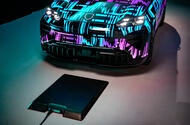How Does Porsche’s Wireless Charging Pad Actually Work?
Ever wished you could charge your electric car without fumbling for a cable or worrying about plugging in during a rainstorm? Porsche’s new Cayenne Electric is about to make that a reality. The company is rolling out what it calls the Porsche Wireless Charger (PWC), a manufacturer-backed inductive charging pad that lets you juice up your SUV simply by parking over it. No more cables. No more wallboxes. Just park, and let the magic happen.
So, how does it work in practice? As you approach the pad, the Cayenne’s digital display switches to a camera view with helpful gridlines, guiding you to align perfectly. Once you’re in place, the car’s air suspension lowers the body a few centimeters, bringing it closer to the pad. Then, a magnetic field kicks in, and—without a sound—the battery starts charging. It’s as close to invisible as technology gets.
What Makes This Charging System Stand Out?
Porsche isn’t the first to dream up wireless charging for cars, but it’s the first major automaker to offer a fully integrated, manufacturer-supported solution. The PWC delivers up to 11kW of power, which is on par with many home wallboxes, and it works in just about any weather—from frigid -40°C mornings to sweltering 50°C afternoons. Debris like leaves or snow? Not a problem. The system is designed to maintain about 90% efficiency, so you’re not losing much compared to plugging in.
One clever touch: the pad is self-sufficient. You don’t need to install a wallbox or run extra cables. However, you can’t embed the pad into your garage floor, since that would block the sensors that help the car align itself. Instead, the 60mm-tall, 50kg pad sits above ground, ready to go wherever you need it.
Is It Safe for Pets, Kids, and Everyday Use?
Safety is a big concern with any new tech, especially when it involves high-powered magnetic fields. Porsche has built in several safeguards. For example, if your neighbor’s cat decides to nap on the warm pad, the system’s foreign object detection will instantly shut off the magnetic field. Once the coast is clear, charging resumes automatically. It’s a thoughtful touch that shows Porsche is thinking about real-world scenarios, not just lab conditions.
What About Cost and Installation?
Let’s be honest: cutting-edge convenience doesn’t come cheap. All UK-spec Cayenne Electrics will be pre-wired for the system, but the actual hardware is optional. The water-cooled charge receptor, which bolts behind the car’s underbody, adds about 15kg and costs around £2000. The charging pad itself is another £3000. So, you’re looking at a £5000 investment for the full wireless experience.
On the bright side, you don’t need a wallbox, and the system is designed for easy setup. If you’re already investing in a luxury electric SUV, the added convenience might be worth the splurge.
Can You Upgrade to Faster Charging in the Future?
Here’s where things get a bit nuanced. While the PWC is cutting-edge today, Porsche is clear that if faster wireless charging becomes available down the road, you’ll need new hardware—not just a software update. That’s a limitation to keep in mind if you’re hoping to future-proof your setup.
How Does It Fit Into Your Connected Lifestyle?
Porsche knows its customers expect more than just a fancy charging pad. The PWC comes with built-in LTE and wireless LAN modules, so you can control everything from the My Porsche app. Start or stop charging remotely, schedule sessions for off-peak electricity rates, or precondition your car before you head out. It’s all about making the experience as seamless as possible.
How Does This Compare to Traditional Charging?
For many EV owners, plugging in at home is already pretty easy. But wireless charging takes things to another level—especially if you’re tired of cables or have mobility challenges. The system’s 11kW charging speed matches many home solutions, and its efficiency is impressive for wireless tech. Plus, there’s the sheer cool factor of parking and walking away while your car charges itself.
However, if you’re looking for the absolute fastest charging speeds, cabled solutions still have the edge. Porsche’s own Cayenne Electric will support up to 400kW via cable, which is leagues ahead of the wireless pad. So, think of the PWC as a convenience feature for daily top-ups, not a replacement for rapid charging on road trips.
What’s the Real-World Impact for EV Owners?
This isn’t just a flashy gadget for tech enthusiasts. For families, busy professionals, or anyone who values convenience, wireless charging could be a game-changer. Imagine never having to wrestle with a frozen cable in winter or worry about tripping hazards in your garage. It’s a small detail that can make EV ownership feel more effortless.
Industry experts see wireless charging as a key step toward wider EV adoption. According to a 2023 report from the International Energy Agency, convenience and ease of use are among the top factors influencing EV purchase decisions. By removing one more barrier, Porsche is helping to make electric cars feel less like a compromise and more like a natural choice.
The Bottom Line: Is Wireless Charging Worth It?
Porsche’s wireless charging pad for the Cayenne Electric is more than just a party trick—it’s a thoughtful, well-engineered solution that addresses real-world pain points. It’s not cheap, and it won’t replace ultra-fast charging for road trips, but for everyday use, it could make living with an EV a whole lot easier.
If you’re already considering a high-end electric SUV, the added convenience and seamless integration might just tip the scales. And as the technology matures, expect to see wireless charging become a standard feature—not just for luxury cars, but across the EV market. For now, Porsche is leading the charge—literally and figuratively.

